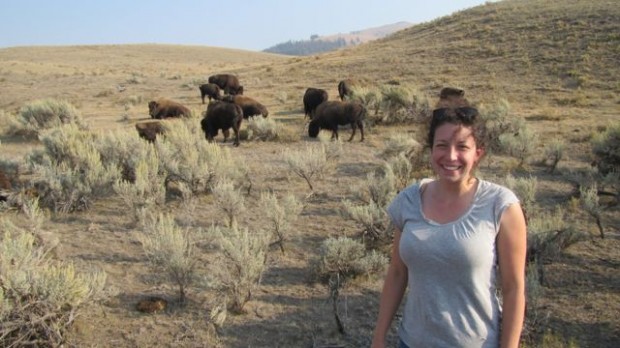Contact
cgstorer@gmail.comResearch Summary
When in the Hulcr lab, Caroline used to study how the bizarre genetics of Xyleborini ambrosia beetles, which includes sib-mating, inbreeding, and haplo-diploidy, contributes to the success of these incredibly diverse fungus farming insects. To learn more about her research interests please visit: about.me/caroline.storerFormer projects
- What is the population structure of globally distributed ambrosia beetles in the tribe Xyleborini?
- How does population structure differ between outbreeding and inbreeding ambrosia beetles and between ambrosia beetles in their native and exotic range?
- Is complete inbreeding maintained throughout a species range? Is it maintained across different species?
- What emerging molecular tools are best suited for studying the genetics of these tiny inbreed beetles for which we only have DNA sequences of a few genes?
Bio & Education
- 2013-present: Graduate Assistant, School of Forest Resources and Conservation, University of Florida
- 2011-2012: NSFGK12 Graduate Teaching Fellow, Friday Harbor High School
- 2009-2012: M.S. in Aquatic and Fishery Sciences, University of Washington with Steven Roberts and Jim Seeb
- 2005-2009: B.S. in Marine Science, Eckerd College
Publications
Steininger, M. S, Storer, C., Hulcr, J., Lucky, A. (2015) Alternative preservatives of insect DNA for citizen science and other low-cost applications. Invertebrate Systematics, 29:468-472
Storer, C., T. Quinn, and S.B. Roberts. (2013). Quantitative PCR analysis used to characterize physiological changes in the brain tissue of senescent sockeye salmon. Biogerontology 14(15):483-490. doi: 10.1007/s10522-013-9448-1
Storer, C.G., C.E. Pascal, S.B. Roberts, W.T. Templin, L.W. Seeb, and J.E. Seeb. (2012). Rank and order: evaluating the performance of SNPs for individual assignment in a non-model organism. PLoS ONE 7(11): e49018. doi:10.1371/journal.pone.0049018
Storer, C.G., R.C. Harbeitner, A. Rickli-Rahman, N.W. Van Bibber and W.A. Szelistowski. (Submitted). Molecular population structure and biogeography of the Gulf pipefish, Syngnathus scovelli, in Florida waters. Journal of Biogeography.
Storer, C.G., S.B. Roberts, F. Goetz. (In prep). RNA-seq provides insight into lake trout ecotypic differences. Molecular Ecology (intended).
Presentations
Storer, C., Bateman, C., Kostovcik, M, & Hulcr, J. 2013. Incredible invaders: How bark and ambrosia beetles are colonizing the world. Smithsonian Marine Station at Fort Pierce Seminar Series, December 6, Fort Pierce, FL.
Storer, C.G. & Hulcr, J. 2013. Using genotype-by-sequencing to uncover the population history of fungus farming ambrosia beetles. Entomological Society of America Annual Meeting, November 9-14, Austin, TX.
Smith, D., Storer, C.G., Frazee, N., & Vermeire, M. 2011. Presentation: University of Washington Graduate Students in the High School: Who’s Teaching Who? Western Society of Naturalists Conference, November 10-13, Vancouver, WA.
Storer, C.G., C.Pascal, S. Roberts, L. Seeb, B. Templin, & J.Seeb. 2011. Presentation: Rank and order: evaluating the performance of sockeye salmon SNP assays. American Fisheries Society Annual Meeting, September 2-8, Seattle, WA (Awarded AFS James E. Wright Graduate Award for excellence in fisheries genetics).
Storer, C.G. 2010. Presentation: Rapid senescence in sockeye salmon: insights from telomeres. Alaska Salmon Program Symposium, University of Washington, December 10, 2010, Seattle, WA.
Storer, C.G. 2009. Presentation: Molecular population structure and biogeography of the Gulf pipefish, Syngnathus scovelli, in Florida waters. Annual Meeting, Florida Chapter American Fisheries Society, February 17-19, Altoona, FL (Awarded Runner-up, Best Student Oral Presentation).
Storer, C.G., E. Naro-Maciel, K. Holmes, R. DeSalle, and D. Brumbaugh. 2008. Poster: Genetic differentiation of spiny lobster, Panulirus argus, populations in the Caribbean and implications for conservation. Ocean Sciences Meeting, March 2-7, Orlando, FL.
Misiewicz, T., C. Storer, N. Zerega. 2007. Poster: Investigating the evolutionary history of the genus Dorstenia (Moraceae). Botany and Plant Biology Joint Congress, July 7-11, Chicago, IL.
Outreach
Most recently, I taught part-time at Friday Harbor High School on the San Juan Islands as part of the OACIS NSF GK12 Teaching Fellowship. Throughout the year I co-taught and developed new lesson plans to introduce modern science to the high school classroom. A few lessons I modified and developed include “A need for speed: an intro to enzymes”, “Harmful algal blooms”, and “Estimating population size”.
In the past I have been involved in outreach activities as president of the University of Washington Student Chapter of the American Fisheries Society.
Additionally I like to stay connected to new research, scientific discourse, relevant issues via twitter and google+.
You can follow me on goggle+ here and on twitter below.



